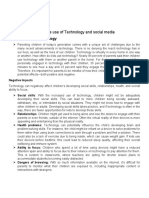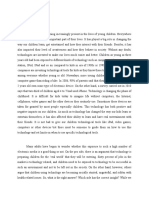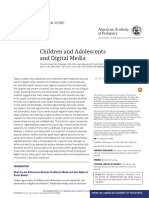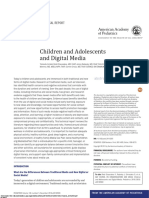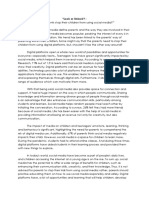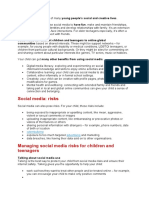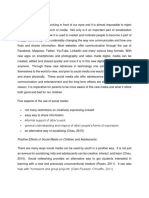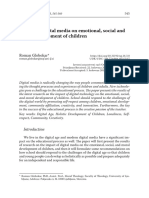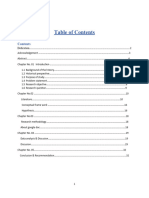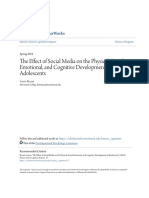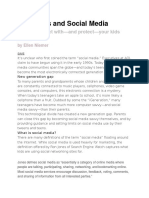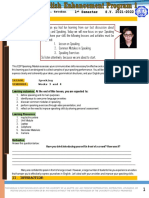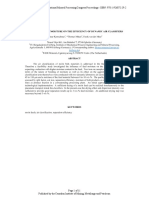Republic of the Philippines
Eastern Samar State University
Salcedo Eastern Samar
CHILDREN USES TECHNOLOGY
AND SOCIAL MEDIA
PROPOSAL
AUTHOR: TZ ALDAHDOUH
Researchers:
Corre, Jonette, Gullan.
Abendano, Ronalyn, Belicario
December, 2022
TABLE OF CONTENTS
1
�Chapter 1 : INTRODUCTION………………………………………………….. 4
Background and Rationale……………………………………………. 4-5
Objectives of Study………………………………………………………5
Scope and Limitation……………………………………………………. 6
Chapter 2: REVIEW RELATED LITERATURE AND STUDY…………….. 7
Related Literature…………………………………………………………7-9
Related Studies…………………………………………………………… 9
Chapter 3: Planning and Designing and Specification…………………10
Gantt Chart………………………………………………………………….10
Flow Chart……………………………………………………………………..11
2
� Abstract
As a result of high-tech developments and the increase in the importance of the
global communication, social media websites and applications have occurred as a
new way of communication and self-expression in the contemporary world.
Globalization has forced people to obtain and spread the necessary information
quickly, and due to this requirement, people of all ages have had to acquire digital
skills which they utilize to meet their need of learning and being informed about the
issues happening around the world. Social media tools and applications are being
highly and commonly used all round the world by all kinds of people from all ages in
order to express themselves, get to know other people, share their opinions and
learn others' opinions on the world issues, socialize, and have fun. Regarding its
effects on children, social media has both advantages and disadvantages.
3
� CHAPTER 1
INTRODUCTION
Background and Rationale
Children’s has never been easy. But the widespread adoption of smart
phones and the rise of social media has introduced a new wrinkle to the challenges
of a child, those who have children.
According to a Pew Research Center survey conducted in March, one of the
most highly discussed and debated topics among children today is screen time and
what impact will screens have on children’s development, the World Health
Organization issued guidelines last year on the amount of time young children
should spend in front of screens.
Nowadays, some parents with a child in this age range already believe their
child spends too much time on certain devices, including a smart phones. These
worries come at a time when it is fairly common for children of all ages to engage in
some way with digital devices, but there are wide age gaps parents who have an
older child, between the ages of 5 and 11 (46%), are more likely than parents with a
child age 3 to 4 or 2 or younger to say their child uses or interacts with type of
technology.
In our modern, tech-infused society, it seems like children are practically born
with a smart phone in their hands. How many of us has been toddlers sitting in their
strollers casually tapping and swiping on their parents? Although it is ultimately
depends on your parenting style, you can look to the American Academy of
pediatrics (AAP) as a guide. They recommended that children not to be exposed to
any technology before two years of age. Indeed, there are countless articles
regarding the harmful effects of exposing children to technology at very young
ages.
4
� The concept to use technology and social media to have fun, make and maintain
friendships, share and learn interests, explore identities and develop relationships
with family.
Objectives of the Study
This study is how children can use technology and social media to better
understand, extend or share what they’re learning at school, either informally or in
formal school.
Specifically, it had the following objectives:
1. Technological it means that children are becoming computer experts
at a very young age;
2. Learning from a very young age about technology, they’re making
huge studies as they grow in being prepared for schooling, Future
careers, innovations, and more.
3. Children can start getting technological skills early that they’ll need in
the future.
Significance of the Study
This study was beneficial to the following:
Learning Children can use social media to better understand,
extend or share what they’re learn.
Hobbies and interest: Child can use social media to follow their
interests and learn new ones.
Creativity: it can be creative with profile pages, images, video and
game modifications.
Mental health and well being: Connecting with extended family
and friends and taking part in local and global online groups can
give your child a sense of belonging.
5
�Scope and Limitation of the Study
This statement seeks to identify the many positive benefits of media and
digital technology for children and adolescents, but also recognizes areas of concern
and it continues to increase dramatically as digital technology becomes more readily
available. Social media has become a common method of communication and online
gaming provides a further avenue for interaction.
The study provide young people with opportunities to connect with friends
and family and develop technical and creative skills. These sites facilitate connection
to a diverse and widespread group of people, providing a greater understanding of
global issue’s and it is evidence that engagement with digital delivery of material
allows children and young people to enhance and consolidate learning on an almost
inexhaustible range of topic.
They can also promote social interaction, communication and emotional well
being and children and young people who have access to media technology and who
take advantage of opportunities such as these could be enriched, especially where
this access is in the
context of other life experiences and opportunities the promote social interaction,
learning and exercise.
The children learn the importance of building communities and how to interact
with people in social situations.
6
� CHAPTER 2
REVIEW OF RELATED LITERATURE AND STUDIES
This chapter presents the different literature and studies conducted that are relevant
to the present problem.
Related Literature
Today the availability of technology has increased, so to has the time people
spend consuming online content. Today’s children are born into a digital world,
where communications technologies and the internet are becoming increasingly
accessible. The growth in the use of such technologies is driven, in large part, by
the use of social media. According to Teresa Treviño, the use of social media can be
observed among all the age groups, and children are 90 percent of teenagers report
using social media on a daily basis, one in ten children’s own a mobile device, like
smart phones or tablet by the age of five.
The children participated in the study discusses the social media platforms
most commonly used by children and finds that the online content consumed by
children influences their purchases in a way that can result in tangible marketing
outcomes, such as increased Demand for trending products, as well as the creation
of new products and services. The findings suggest that they would do well do
identify the social media platforms used by the Segment.
Children used social media it is a big part of social and creative life for preteens
and teenagers use social media to have fun, and maintain friendship, share and learn
interests, explore identities and develop relationship with friends and with family, In
addition to problematic digital behavior, there may be changes in children’s daily
behavior at home Like increased irritability, increased anxiety, lack of self esteem.
7
� According to Luhmann, Niklas 2000, children use technology and social media is to
share of ideas thoughts, and information through visual networks and communities.
Social media is based and gives users quick electronic communication of the
content, such as personal information, documents, videos, and photos. The children
engage of social media via computer, tables or smartphones by web based software
or applications.
The power of social media is the ability to connect to share information with
anyone on earth, or with many people simultaneously. There are more than 3.8
billion user of children using technology and social media between the age of 18 and
29 use for business or posting and etc, to know that the children know more about
using of technology.
The computerized of technology and social media that the young children can
learn reading skills through images and video. They can strengthen their math skills
by learning data computing through technology. Children can also improve their
social skills by learning how to communicate in a concise fashion (Oct 18, 2013).
Social Media is a vast network that includes various modes of communication
with clients. It consists of email, instant messaging, social networking,
telecommunications, blogs, videoconferencing, online business meetings and much
more. Social media has become an indispensable part of a business as it is a very
convenient way to communicate and get the work done. Social media has gained
much more importance as technology too is becoming more user-friendly. There has
been a growth in social-based operating systems and software applications. It is
evolved as a desired place to display brands. Businesses wish to promote their
brands online as social media has a notable influence on consumer's purchasing
decisions. It offers the convenience of finding and has become the best place to
gather insights about the buying behavior of consumers. With the ever-growing
competition, businesses do not want to miss out on the social media bit. Sometime
8
�back, the only purpose of social media was to get in traffic, but now as a huge
influence factor. Brands can easily interact with a new audience more quickly and
easily. (Stefan Thurairatnam 2015).
Centralized social media continues to breach our trust. Seemingly benign quizzes
and games leak our data and our friends’ data to huge organizations with vote
garnering and money-making motives. News feeds don’t provide accurate and
well-rounded perspectives on current events. Advertisers stalk us from one website
to the next.Fortunately, a wave of visionary of our current social media framework
through decentralization. Here’s an overview of the problems with the most popular
platforms and how they might be solved (The Technology and social media 2019).
Related Studies
A study conducted in International Education Studies is an attempt to
examine resources and interaction with academicians in higher education institutions
across the boundary wall, a hitherto unexplained area of research. This empirical
study is based on the survey of 360 students of a university in eastern India,
cosigning students’ perception on social media and mobile devices through
collaborative learning, interactivity with peers, teachers and it has a significant impact
on students’ academic performance.One important way to help them stay safe while
using social media is to monitor their usage. Just like when our children spend time
with their friends in real life, we need to know what they are doing and who they are
talk to through social media platforms.
According to the Agencies using social media as a practice tool is a relatively
new approach. Organizations serving youth and families have recognized that the
use of social media has spread greatly among the populations they serve. Although
social media can be used to improve the effectiveness of working with children and
families, it also presents Challenges,
9
� CHAPTER 3
Planning and Designing
and Specification
GANTT CHART :We made this Gantt chart to see how we plan for a week and
research, this is the longest line in our Gantt chart is research because it's what we
focused on to get an idea for our project proposal.
DECEMBER 2022
Task Name 1 WEEK 2 WEEK 3 WEEK 4 WEEK 5 WEEK
Planning
Research
Design
Implementatio
n
Finished
10
� FLOW CHART:
Star
t
And to educate the children
Keep an open dialogue
on the risks of social
of childrens.
meadia.
Follow the age
Try parental control
requirement
guidelines
Create screen-free
times and teach by Establish clear family
limiting during study rules
time.
Help children to
Watch and play
identify healthy
together
behaviors.
To have fun and make maintain friendships and they’ll share
and learn interests to explore the identities and develop
relationship with family .
11
�12


